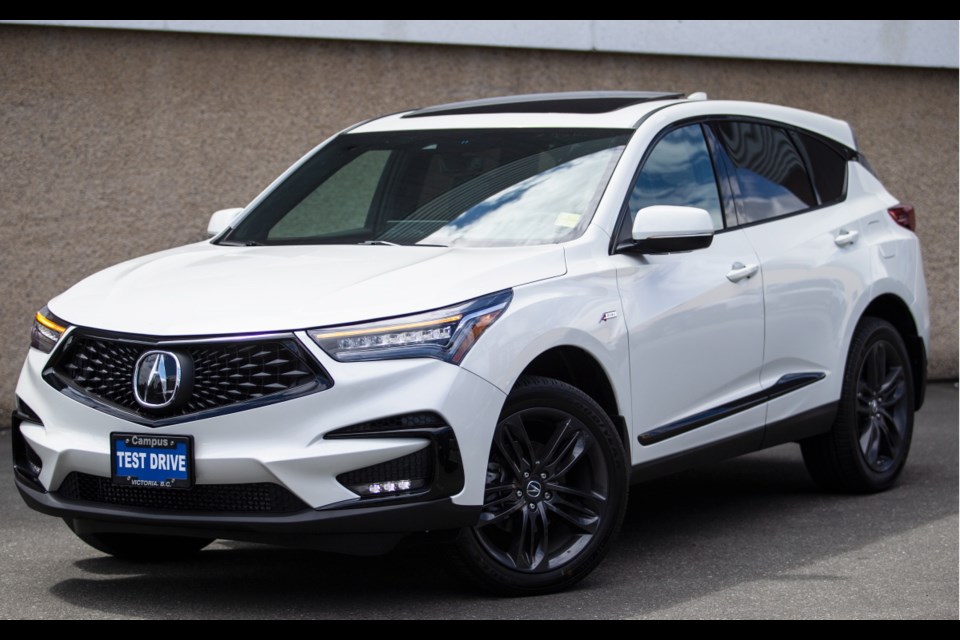The 2019 Acura RDX represents the model’s coming of age.
As the entry-level crossover for the premium brand, the RDX has always borrowed from its Honda counterpart. The early vehicles were little more than badge-engineered versions of the CR-V.
But with the recent arrival of the third generation, the new RDX has finally graduated into deserving its own platform.
This new-from-the-ground-up revamp will hopefully define its coming-of-age moment, as it goes bumper-to bumper against others in the luxury compact crossover segment.
There are five trim levels, starting at $43,990. I drove the A-Spec trim, with a list price of $50,290.
The exterior of the 2019 RDX is longer and wider, but a whisker shorter, than the vehicle it replaces. Significantly, the wheelbase has grown from 2,685 to 2,750 millimetres.
Under the hood, the RDX has also come full circle, dropping last year’s V-6 in favour of a turbocharged four — something that the original CR-V offered back in 2006, when the first model hit our shores.
The new turbocharged 2.0-litre four-cylinder engine, at 272 horsepower, is seven horses short of last year’s model — but the boost in torque, from 252 to 280 pound-feet of torque more than make up for this. An important detail is that the torque now comes on strong as low as 1,600 rpm, and is felt almost immediately, with little turbo lag.
Drivers can select between Comfort, Sport or Sport-plus drive modes (there is also a Snow mode) to reflect their driving style, with changes to the steering, throttle and transmission shift point.
The six-speed automatic transmission is history, replaced by a 10-speed unit. This a one smooth customer, with almost imperceptible upshifts and the ability to skip gears when downshifting.
There are steering-wheel-mounted paddles that react quickly when activated.
In Canada, all RDX models come standard with Acura’s Super Handling All-Wheel Drive. Acura has refined the system so that it now can send up to 70 per cent of the torque to the rear wheels — surprising, as this is a native front-wheel-drive vehicle.
It gets better, especially for people who love lonely back roads. The system can appropriate up to all of its power to either the left or right wheel when cornering, creating a yaw moment (essentially enabling the vehicle to turn more sharply). The new suspension settings minimize lean when cornering, as well.
This alleviates the plowing feel of vehicles that carry most of their mass over the front wheels — basically, most of the vehicles on the road. The RDX feels lighter and maintains a tighter line when pushed. With the traction control turned off on a winding road, it almost feels like a rear-wheel-drive vehicle.
Keep in mind that this technology is in a crossover, not a low-slung sports coupe.
The variable-ratio, electrically assisted power steering still isn’t as sharp or as precise as the BMW X3, but does manage to set a new high-water mark for the segment.
The A-Spec is the performance-oriented model in the line, and is the only model equipped with larger 20-inch wheels and 255/45 R20 tires.
The interior has received plenty of attention as well. The seats are nicely sculptured, and the fit and finish is of a high standard. The main changes centre around the centre console. A large knob — the drive selector — takes centre stage. The traditional gear selector is conspicuously missing. In its place is a push-button affair that you will find increasingly in other Honda products. Stabbing the D button twice puts it into S mode.
The heart of the infotainment system is a 10.2-inch screen perched on top of the console. A touchpad that Acura calls the True Touchpad Interface is found aft of the drive selector.
You can move an icon, tap or even trace letters or numbers with your finger. I appreciate what Acura is trying to do, but I still prefer either a touchscreen or a knob.
A pad is fine at home, but in a constantly moving vehicle, the results are sometimes less than stellar. The funniest is when you try to trace out a letter or number and you hit a bump on the road. A pair of physical buttons ensure you can always go back or find the home screen.
Compared with, say, an Audi, the RDX cockpit feels “busy” with multiple curves, creases, buttons and displays.
A welcome addition is the ability of the RDX to serve as a 4G LTE Wi-Fi hotspot for all your passengers.
The 2019 Acura RDX represents a new level of confidence apparent in recent introductions by the premium brand, such as the re-introduction of their NSX supercar.
It also represents a not-too-subtle challenge to competitors in the luxury/sports crossover segment — a challenge they would be foolish not to take seriously.
THE SPEC SHEET
Type: Luxury compact crossover, front engine, all-wheel-drive
Engine: Turbocharged 2.0-litre four-cylinder, 272 hp at 6,500 r.p.m., 280 lb.-ft. of torque between 1,600 and 4,500 r.p.m.
Transmission: 10-speed automatic
Dimensions (mm): Length, 4,744; width, 1,900; height, 1,668; wheelbase, 2,750
Curb weight (kg): 1,844
Price (base/as tested): $50,290/ $52,460 (includes $2,045 freight and PDI $25 tire duty and $100 AC tax)
Options: Nil
Tires: 255/45 R20 on alloy wheels
Fuel type: Premium
Fuel economy (L/100km): 11.3 city/ 9.1 highway
Warranty: Four years/80,000 km new car, five years/100,000 km powertrain and roadside assistance



